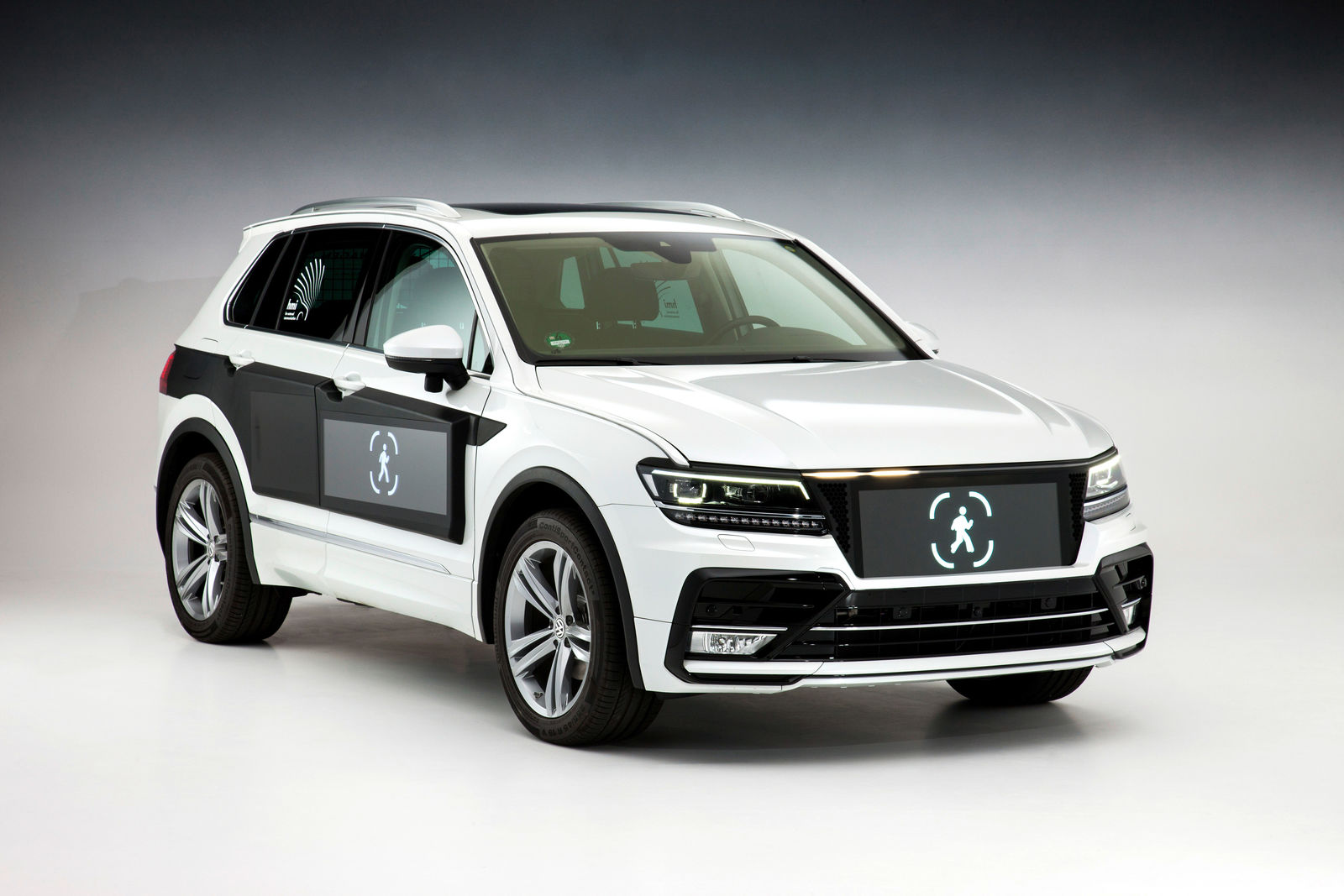TIGUAN – VISUAL MODALITY
The communication channels between road users will change with the launch of the first assisted driving cars. Whenever a driver does not actively control a vehicle, the car itself must be able to communicate with other drivers, vehicles and pedestrians to ensure maximum safety and comfort. The new communication channels are also intended to optimise cooperation and build trust with other road users. Volkswagen Group Research is testing these future communication processes with a specially equipped Tiguan.
Research vehicle with exterior HMI
The research vehicle is currently equipped with three different technologies for 360-degree communication. Four large liquid crystal displays (LC displays) are integrated in the doors as well as the front and rear ends. There is also a 360-degree LED multi-colour strip all round. In addition, so-called multi-lens arrays are mounted in the corner areas of the body. Using these light projection and display technologies – known as visual modalities – the researchers can investigate the possible behaviour of road users in various scenarios in the future. The visual elements themselves merge to form an exterior HMI (Human-Machine-Interface). This HMI communicates with other road users and informs them about the planned driving manoeuvres of the car. The LC displays show information and warnings, while the multi-lens arrays in the front and rear ends generate visual protection and communication information onto the road. The 360-degree light strip interacts in parallel with the LC displays and supports external communication via animated lighting concepts. All this is combined with audio signals in order to integrate as many senses of the road users as possible into the communication. In addition, high-resolution headlight technologies are examined in parallel in order to integrate further functions into the overall concept of the exterior HMI on the basis of visual projections.
Light becomes a human-machine interface
Assisted driving is gradually finding its way into the Volkswagen of today, tomorrow and beyond. Systems such as Traffic Jam Assist, which in certain situations (that are still monitored by the driver) automatically take over the longitudinal and lateral control of a Volkswagen, are already available. In the future, there will also be modes in which the vehicles operate independently without driver monitoring (VDA levels 4 and 5 for automated driving). However, to be able to use the advantages of such assisted journeys optimally and safely, a new approach to human-machine communication needs to be developed. For example, In the case of unclear situations on priority roads, eye contact and gestures are used nowadays – this will often be omitted in the future. However, as a result of the new type of communication, trust and understanding can be built up for such situations at an early stage. And this will optimise the flow of traffic, as the vehicle no longer has to come to a standstill. To take advantage of these benefits of the assisted driving mode, Volkswagen Group Research is working on an HMI such as the one used in the exterior of the Tiguan research vehicle.
Exterior HMI can also be used in today's traffic. The exterior HMI is designed to intuitively understand and trust the vehicle's behaviour and to enable an intuitive prediction of possible driving manoeuvres. However, the exterior HMI offers great added value not only for tomorrow's assisted driving cars, but also for today's traffic and vehicles. A general example of this is an end-of-traffic-jam warning via car-to-car and/or car-to-x communication that could help to make situations clearer, thus preventing rear-end collisions and increasing safety on motorways. The Tiguan built by Volkswagen Group Research is the first research vehicle with such a versatile exterior HMI that can be used in real traffic situations. The researchers thereby leave the closed interior, which can be controlled by the driver, as a field of interaction in order to master new areas of design and, at the same time, meet new technological requirements.
Various technologies are used, developed and evaluated here in order to derive the best possible technological and conceptual recommendations for action. At the same time – and this is crucial – Volkswagen is once again putting people at the centre of its research: pedestrians, cyclists, car users and motorcyclists. In addition to the consideration of perceptual psychological processes in a communication process, the needs of users are also identified in the studies. This is done on the basis of online surveys, interview and video studies, studies in virtual reality and with the prototype in real road traffic. The overriding goal is to realise an increase in safety for everyone via exterior HMI.
